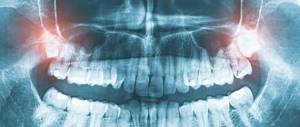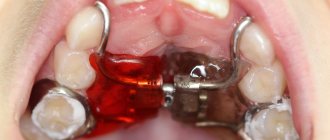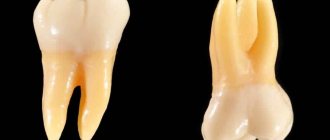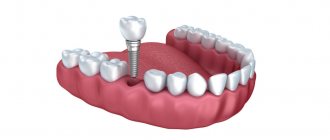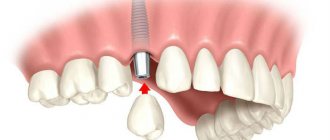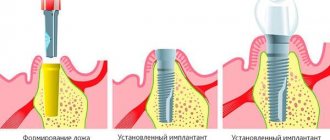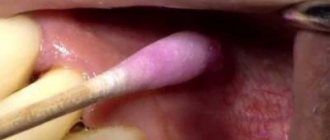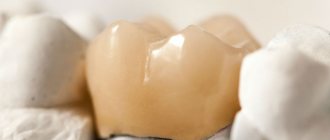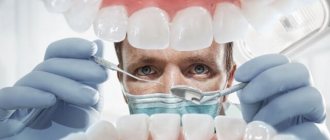A maxillary fracture is an injury in which bone fragments are displaced in such a way as to disrupt the correct position of the upper jaw relative to the lower jaw. The patient is unable to close his mouth, any movement is accompanied by increased pain. If the injury was accompanied by rupture of the gums by sharp fragments, moderate bleeding is present.
Jaw fractures can be either traumatic (resulting from mechanical force) or pathological (caused by osteomyelitis, an extensive cyst or a malignant tumor). According to the place of formation and method, fractures of the upper jaw are divided into closed and open; the latter are much more common due to the anatomical features of the bone tissue.
Fractures of the upper jaw are often the result of mechanical impact from a blunt and hard object. The direction of the impact determines in which direction the bone fragments will be displaced. The most vulnerable parts of the jaw are at greatest risk: the places where the upper jaw connects to the lower jaw, or where it connects to the skull.
Types of Maxillary Fractures
Often this type of injury occurs after a powerful collision. Loss of consciousness is often a symptom of a concussion. The most serious consequences include damage to the base of the skull.
Lefort's typology classifies three types of mandibular fractures:
• The first, or subbasal type of fracture is a type of injury to the lower jaw, in which the damage gap runs parallel to the alveolar process: it passes through the base of the nose, the zygomatic arches, and often through the anterior and middle cranial fossae. With this type of fracture, severe displacement occurs relatively rarely. The fragments can be mobile, and the dentition is often disturbed. Nosebleeds often occur, caused by trauma to the mucous membrane of the maxillary sinuses.
• The second is the suborbital or middle type of fracture - the fracture passes through the base of the nose, the lower wall of the orbit, and the zygomatic-maxillary suture. In this case, the upper jaw is broken off along with the bones of the nose and cheekbone. This is often accompanied by profuse bleeding from the nose and malocclusion due to the fact that the jaw has been significantly displaced downward. There are dark red bruises around the eyelids – this is called the “spectacles sign”.
• The third is the lower type of jaw fracture. The fracture crosses the base of the pyriform foramen through the base of the maxillary sinuses. The fracture gap also goes through the bridge of the nose or eye sockets, and the zygomatic bone breaks off. This is the type of fracture that most often causes concussions.
Maxillofacial Surgery
Maxillofacial surgery ¦ Jaw fractures - classification of jaw fractures
Jaw fractures are perhaps the most important among all injuries to the bones of the facial skeleton. Moreover, their predominant number (about 70%) are fractures of the lower jaw, which are most often double and triple, which is explained by the shape of the bone, which has the shape of a horseshoe, and are accompanied by a concussion.
Depending on the etiology (cause), nature of the fracture, its line and a number of other signs, there are various options for jaw fractures. According to their etiology, they are primarily divided into traumatic, which occurred under the influence of one or another external force, and pathological, spontaneously or spontaneously arising against the background of a disease process occurring in the bones (for example, with osteomyelitis, tuberculosis or tumor lesions, with syphilis, etc. .). As for traumatic fractures of the jaw, it is also necessary to take into account the fact that the injury can be gunshot or non-gunshot. Gunshot fractures of the jaw are quite often comminuted and are complicated by bone defects of varying sizes and depths.
Fractures of the jaws are also divided into complete, associated with a pathological change in the continuity of the damaged jaw, and incomplete, such as depressions, fractures and cracks, as well as closed, when neither the skin nor the mucous membranes are damaged, and open, when the integrity of the external integument is broken or directly traumatic agent, or the sharp edge of a bone fragment. Open fractures are absolutely always infected and are usually characterized by more severe clinical symptoms. By the way, fractures of the alveolar processes of both jaws and the body of the lower jaw are almost always open due to the fact that the mucous membrane covering the bone is intimately connected to the periosteum and in the vast majority of cases, damage to the mucous membrane occurs in parallel with the bone fracture.
Based on the characteristics of the jaw fracture line, straight, longitudinal, transverse, oblique, zigzag, and the above-mentioned comminuted fractures are distinguished. According to the number of fragments, fractures can be single, double, triple and multiple, and according to the mechanism of occurrence, direct, occurring directly at the site of exposure to traumatic force, and indirect, occurring far from the place of application of force (for example, a fracture in the neck of the articular process after a blow to the chin ).
Additionally, in the lower jaw there are median fractures localized in the area of the central incisors, mental (lateral) - in the area of the mental foramina or the canine area, angular (angular) or antiangular - in the area of the angle of the lower jaw or in front of it, cervical (cervical) - in area of the neck of the articular processes.
Fractures of the upper jaw are divided into fractures of the alveolar process, orbital (subbasal), suborbital and fractures of individual bones of the facial skeleton. Suborbital fractures are those that extend below the infraorbital foramen. In turn, they are linear, perforated and splintered. If the fracture line runs under or near the base of the skull, the fractures are called subbasal or orbital. Orbital fractures, since they are located closer to the base of the skull, are more severe in their course than suborbital ones.
(495) 506-61-01— Where is the best place to have brain surgery?
REQUEST TO THE CLINIC
Treatment of a mandibular fracture
In cases of jaw injury, the most important treatment measure is proper first aid. The injured bone needs complete rest to avoid more serious complications. Therefore, the first step is, if possible, to carefully bring the lower jaw closer to the upper jaw and fix them in this position. A scarf or long belt will work well for this purpose if you don't have a strong bandage at hand.
It is also necessary to use a long support (a ruler, a piece of plywood, a thin strip, etc. will do). It needs to be applied horizontally to the teeth of the upper jaw and secured with something elastic. Since a fracture of the lower jaw is a serious injury leading to many complications, the delivery of the patient to the traumatology department should be as safe and urgent as possible. The patient must be taken to the traumatology department in a supine position. Possible complications include difficulty breathing, heavy bleeding, and negative consequences of a concussion (including unconsciousness).
Answers to the CME test “Treatment of traumatic injuries to the bones of the facial skeleton”
Share with colleagues:
A splint is used to immobilize fractures of toothless jaws
1) Vankevich; 2) Port; + 3) Tigerstedt.
To reposition the zygomatic bone when it is fractured, it is used
1) Kocher clamp; 2) Farabeuf hook; 3) raspatory; 4) spatula; 5) Karapetyan elevator.+
To reposition the zygomatic bone when it is fractured, it is used
1) Kocher clamp; 2) Limberg hook; + 3) Farabeuf hook; 4) raspatory; 5) spatula.
Extraoral devices are used to fix fragments of the lower jaw
1) Zbarzh apparatus; 2) Rudko apparatus; + 3) Porta bus.
An additional method for examining facial bone fractures
1) biopsy; 2) radioisotope research; 3) radiography; + 4) cytological examination; 5) electroodontodiagnostics.
Mechanical injuries of the maxillofacial area in the direction of the fracture gap include
1) closed; 2) zigzag; 3) splintered; + 4) open.
Miniplates for osteosynthesis of jaw fractures are manufactured
1) made of aluminum; 2) made of bronze; 3) made of steel; 4) made of titanium.+
Miniplates are fixed to jaw fragments
1) wire ligature; 2) knitting needle; 3) screws.+
Muscle that depresses the mandible
1) sternocleidomastoid; 2) digastric; + 3) orbicularis oris muscle; 4) the levator anguli oris muscle; 5) actually chewing.
Levator mandibular muscle
1) sternocleidomastoid; 2) digastric; 3) orbicularis oris muscle; 4) the levator anguli oris muscle; 5) actually chewing.+
Levator mandibular muscle
1) temporal; + 2) sternocleidomastoid; 3) digastric; 4) orbicularis oris muscle; 5) muscle that lifts the angle of the mouth.
Dysfunction of the cranial nerves usually occurs
1) when the alveolar process is torn off; 2) with a subbasal fracture of the upper jaw; + 3) with a suborbital fracture of the upper jaw.
A mandatory symptom of a basal skull fracture is
1) bleeding from the external auditory canal; 2) bleeding from the nose; 3) liquorrhea; + 4) pathological mobility of the upper jaw; 5) pathological mobility of the lower jaw.
Orthopedic method of immobilization of fractures of the upper jaw
1) Zbarzh apparatus; 2) Angle's arc; 3) application of bimaxillary splints with a sling-shaped bandage; + 4) osteosynthesis.
The main complaints for a fracture of the upper jaw:
1) pain, dry mouth, bruising; 2) malocclusion, pain, swelling; + 3) severe photophobia, pain, hearing loss.
The main complaints for a fracture of the lower jaw:
1) pain, dry mouth, bruising; 2) malocclusion, pain, swelling; + 3) severe photophobia, pain, hearing loss.
The main symptoms of a fracture of the bones of the zygomatic orbital complex:
1) hematoma of the zygomatic region, dizziness; 2) nasal deformation, hematoma; 3) hemorrhage in the lower eyelid, bleeding; 4) nosebleeds, dizziness; 5) flattening of the zygomatic region, diplopia.+
Main symptoms of a zygomatic bone fracture
1) hematoma of the zygomatic region, dizziness; 2) nasal deformation, hematoma; 3) hemorrhage in the lower eyelid, bleeding; 4) nosebleeds, dizziness; 5) “step” symptom, difficulty opening the mouth.+
The main symptom of a fracture of the upper jaw is
1) headache; 2) nosebleeds; 3) pathological mobility of the maxillary bones; + 4) pathological mobility of the lower jaw; 5) ruptures of the mucous membrane of the alveolar processes.
The main symptom of a mandibular fracture is
1) headache; 2) nosebleeds; 3) pathological mobility of the maxillary bones; 4) pathological mobility of the lower jaw; + 5) ruptures of the mucous membrane of the alveolar processes.
Fractures of the bones of the base of the skull usually occur
1) when the alveolar process is torn off; 2) with a subbasal fracture of the upper jaw; + 3) with a suborbital fracture of the upper jaw.
Under the influence of the traction of the masticatory muscles, the displacement of the upper jaw during a suborbital fracture occurs
1) up and forward; 2) downwards and backwards; + 3) laterally and upwards; 4) medially and forward.
Under the influence of the traction of the masticatory muscles, displacement of the lower jaw in a bilateral angular fracture occurs
1) up and forward; 2) downwards and backwards; + 3) laterally and upwards; 4) medially and forward.
After applying bimaxillary splints with hooking loops, the rubber rings (traction) are changed
1) 2 times a week; 2) 3 times a month; 3) daily; 4) monthly; 5) weekly.+
The cause of diplopia due to a fracture of the zygomatic bone
1) inflammatory reaction; 2) intraorbital hematoma; 3) displacement of the eyeball; + 4) injury to the eyeball; 5) optic nerve injury.
The reason for difficulty opening the mouth due to a fracture of the zygomatic bone
1) inflammatory reaction; 2) hematoma; 3) displacement of fragments.+
The symptom of loading in fractures of the upper jaw is determined by pressure
1) on the hook of the pterygoid process from bottom to top; + 2) on the chin with the mouth half open from bottom to top; 3) on the chin with teeth closed from bottom to top; 4) on the cheek bones from bottom to top.
The load symptom in mandibular fractures is determined by pressure
1) on the hook of the pterygoid process from bottom to top; 2) on the chin with the mouth half open from bottom to top; + 3) on the chin with teeth closed from bottom to top; 4) on the cheek bones from bottom to top.
Synonym for fracture of the upper jaw according to Le Fort I
1) separation of the alveolar process; + 2) subbasal; 3) suborbital.
Synonym for fracture of the upper jaw according to Le Fort II
1) separation of the alveolar process; 2) subbasal; 3) suborbital.+
Synonym for fracture of the upper jaw according to Le Fort III
1) separation of the alveolar process; 2) subbasal; + 3) suborbital.
Lengthening and flattening of the midface indicates
1) fracture of the alveolar process of the upper jaw; 2) fracture of the lower jaw; 3) subbasal fracture of the upper jaw; + 4) suborbital fracture of the upper jaw.
A characteristic symptom of a bilateral fracture of the condylar process of the mandible
1) change in the bite of the molars on the opposite side of the fracture; 2) change in the bite of the molars on the side of the fracture; 3) nosebleeds; 4) open bite; + 5) rupture of the alveolar process mucosa.
A characteristic symptom of a unilateral fracture of the condylar process of the mandible
1) change in the bite of the molars on the opposite side of the fracture; + 2) change in the bite of the molars on the side of the fracture; 3) nosebleeds; 4) open bite; 5) rupture of the mucous membrane of the alveolar process.
Surgical-orthopedic method of immobilization of fractures of the upper jaw
1) Angle's arc; 2) Adams method; + 3) application of bimaxillary splints with a sling bandage; 4) osteosynthesis.
If you find an error, please select a piece of text and press Ctrl+Enter.
Share with colleagues:

